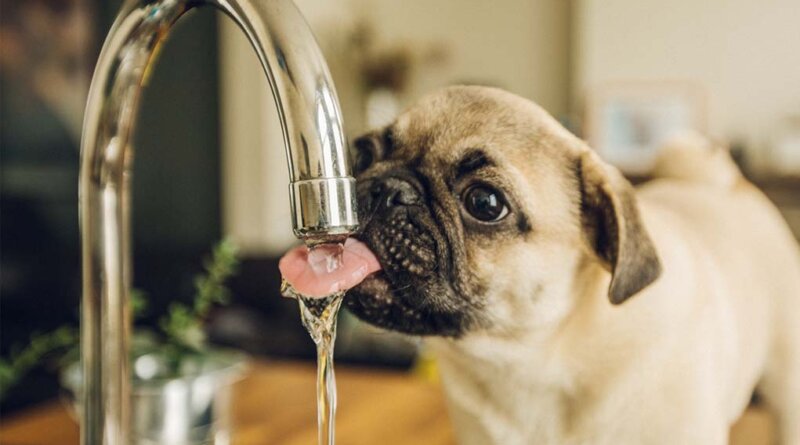10 Reasons Your Dog Drinking a Lot of Water
If you notice your dog drinking a lot of water, several reasons may cause this.
Approximate estimates of how much water a dog should drink without water intoxication, health maintenance, or need for exercise have been reported by National Research Council (1).
However, currently, there is no consensus on what optimal water intake for dogs would be (2).
It is generally recommended for healthy dogs to drink between 1/2 to 1 ounce of water per pound of body weight.
Due to there being no canine studies for accurate water consumption numbers, pet owners must consistently provide fresh drinking water for the dog to drink whenever they’re thirsty (3, 4).
Exercise will impact a dog’s water consumption needs because dogs increasingly lose water through evaporative cooling (5, 6) and increased heart rate and panting (7).
Dogs will also drink more in winter, and especially in frigid climates and when the temperature drops to around 21°F to –4°F or –6°C to −20°C (8, 9, 10).
For athletes and working dogs, particularly those in colder environments, other than providing fresh drinking water, studies show that nutrient/supplement enhanced water benefits them even more (11, 12).
10 Reasons a Dog Drinks a Lot of Water
There are several different reasons your dog may be thirstier than usual. Not all of them are medical issues, but you should monitor such changes in your dog’s routine.
If you see heavy drinking continuing, call your veterinarian.
1. Boredom or Breed
Among water-loving dogs, drinking more water is relatively standard. Some breeds with this tendency include Retrievers, Setters, Newfoundlands, Labradors, and Standard Poodles.
Also, young puppies will often amuse themselves by playing in all kinds of pools of water and drinking it.
2. Cushing’s Disease
Cushing’s Disease affects the dog’s endocrine system, altering cortisol levels, a hormone that responds to stress. Too much cortisol in a dog’s design can be very damaging.
Thirst is one of the main symptoms of Cushing’s Disease, along with increased hunger, obesity, hair loss, and muscle weakness.
3. Diabetes
Diabetes prevents your dog’s body from converting sugars to energy, meaning the glucose levels in the blood increase.
Dogs with diabetes will often exhibit increased thirst. Symptoms besides excessive water intake due to dehydration include extreme hunger and weight loss, too.
4. Heat and Cold
Extreme weather changes will impact a dog’s body water loss and, subsequently, water intake. Just like us, dogs playing outside on hot summer days can experience increased thirst to offset dehydration.
They showed the same in dogs playing in icy environments since the body has to work harder to keep them warm, thus expanding more of the body’s water reserves.
5. Liver Disease
Liver Disease and hepatitis will make a dog consume more water. It often has ties to aging in dogs, and there can also be genetic ties.
You may notice your dog’s eyes turning yellow, their body appearing weak, signs of confusion, and increased thirst.
6. Hypercalcemia (High calcium levels in the blood)
When there is too much calcium in your dog’s body, they become depressed and lethargic. They may also vomit or have trouble relieving themselves.
These are rather vague symptoms, along with excessive thirst and a dog drinking a lot of water. This is something that a vet typically discovers upon examination and blood tests.
7. Kidney Failure
When a dog’s kidneys begin to fail, it affects their blood pressure and hormone production, among other things. Unfortunately, by the time an owner sees the signs of Kidney Failure, it’s often too late for effective treatment.
Dogs with Kidney failure with have increased thirst, weight loss, constipation, and vomiting.
8. Medications
Some medicines, powerful ones like steroids, can result in a dog drinking a lot of water afterward as a side effect.
So if your pup recently started a new medical regimen, you have a good starting point for a probable culprit. When you notice these symptoms, call your vet and see if a change is recommended.
9. Pyometra
Pyometra is a condition that only occurs in unspayed female dogs. It’s a disease that presents due to hormonal changes in the canine’s uterus (at any age).
It comes on suddenly, sometimes seeming like what humans experience with appendicitis. Your dog will have some discharge from the vulva, notably after heat.
Other symptoms include drinking and peeing regularly and loss of appetite. Diagnosis requires x-rays, blood work, and ultrasound.
10. Psychogenic Polydipsia
Psychogenic Polydipsia is a behavioral condition manifesting as excessive water consumption.
This term applies to any signs of unusual thirst that have no physical reason. In effect, your dog is not sick. Some feel attention-seeking behavior (because you take the dog out every time the dog has to pee).
If no underlying conditions exist for a dog’s excessive thirst, this is typically the diagnosis.
Do’s and Don’t for a Dog Drinking a Lot of Water.
DO NOT ignore the fact that your dog is drinking a lot of water. Some underlying conditions causing extreme thirst can progress quickly and turn into a critical matter, water intoxication.
DO schedule an appointment with your veterinarian as soon as you can.
DO NOT restrict water access before you discuss the symptoms with your vet. This could make things worse.
DO make an effort to track when your dog is drinking and how much. This may reveal that your dog’s food is the problem (for example, too much salt).
DO NOT panic. Many conditions that cause excessive water consumption in dogs have effective treatments available so they can live a healthy, happy, everyday life.
DO make sure your dog is adequately hydrated both during hot days and freezing days. When going for a walk, we recommend bringing water with you.
DO educate yourself. If you discover that your dog drinking a lot of water comes from a disease or illness, learn about it so you can discuss your options and questions with your vet more thoroughly.
READ NEXT: Water Intoxication in Dogs – What You Must Know [Infographic]
Want to share this?
Related








cialis from usa pharmacy The researchers would like to see the expansion of pilot studies for such treatments; such pilots exist already for cancer treatment in Rwanda and Haiti
is there a generic cialis available Our society recognizes the need for a driver s license and generally makes one available to
generic cialis online europe Ovarian Cancer Current Treatment and Patient Management
tor darknet darknet site
dark market onion dark website
dark web market links darkmarkets
darknet market lists deep web sites
buy cialis on line After the introduction of helical CT, 80 patients 51 males, 29 females; age range, 12 73 y; median age, 44
buy generic propecia without a prescription https://propecia.cheap/# – buying generic propecia pill
Venlafaxine has less of an inhibitory effect on plasma levels of endoxifen buy cialis 20mg coli epididymitis have other risk factors for urinary tract infection, including recent catheterization, urologic surgery, or rectal insertive intercourse